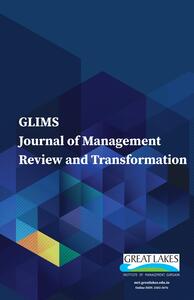
1 JK Business School, Gurugram, Haryana, India
Creative Commons Non Commercial CC BY-NC: This article is distributed under the terms of the Creative Commons Attribution-NonCommercial 4.0 License (http://www.creativecommons.org/licenses/by-nc/4.0/) which permits non-Commercial use, reproduction and distribution of the work without further permission provided the original work is attributed.
No one in the world, particularly the economic community, could have predicted the manner in which the 2019 COVID pandemic erupted or shook the economies. Developing countries, particularly South Asian economies and the lower middle income (LMI) countries (India, Pakistan, Sri Lanka, Bangladesh, Bhutan, and Nepal), had also experienced similar turmoil. The COVID outbreak and trade-related risks were closely associated with exports, imports, international liquidity, and SDR exchange rates, posing time-varying risks. In this sphere, an analytical approach to generate meaningful trade-related time-varying volatility predictions with respect to India’s position is critical while considering the above-listed variables. The Markov-switching (endogenous switching) VAR model using the exponential moving average volatility model (EWMA) of the four macroeconomic variables was used. The author tried to use the EWMA volatility model to witness the impact of spillovers and shock persistence. The present study earmarked the behaviour of time-varying trade-related risks (for Regime 1, i.e., the Early COVID period versus Regime-2 during the COVID period) in terms of the top six economies (as per December 2021 data) when endogenous factors like international liquidity and exchange rate shocks are implemented.
Markov-switching VAR, EWMA volatility, volatility spillover convergences, unilateral convergences, bi-lateral convergences
Addison, T., Sen, K., & Tarp, F. (2020). COVID-19-macroeconomic dimensions in the developing world (No. wp-2020-74). World Institute for Development Economic Research (UNU-WIDER).
Bahaj, S., & Reis, R. (2020). Central bank swap lines during the COVID-19 pandemic. COVID Economics, 2, 1–12.
Baker, S. R., Bloom, N., Davis, S. J., & Terry, S. J. (2020). COVID-induced economic uncertainty (No. w26983). National Bureau of Economic Research.
Baldwin, R. (2020, March). The supply side matters: Guns versus butter, COVID-style. https://voxeu.org/article/supply-side-matters-guns-versus-butter-Covid-style
Baqaee, D., Farhi, E., Mina, M. J., & Stock, J. H. (2020). Reopening scenarios (No. w27244). National Bureau of Economic Research.
Benigno, G., Foerster, A., Otrok, C., & Rebucci, A. (2020). Estimating macroeconomic models of financial crises: An endogenous regime-switching approach (No. w26935). National Bureau of Economic Research.
Bluwstein, K. (2017). Asymmetric macro-financial spillovers (No. 337). Sveriges Riksbank (Central Bank of Sweden).
Bordo, M. D. (2020). Monetary policy cooperation/coordination and global financial crises in historical perspective (No. w27898). National Bureau of Economic Research.
Bordo, M. D., & Siklos, P. (2019). The transformation and performance of emerging market economies across the great divide of the global financial crisis (No. w26342). National Bureau of Economic Research.
Borkowska, D., & Hau, K. (2020). The impact of pandemic shocks to the stock market. Lund University.
Bretscher, L., Hsu, A., & Tamoni, A. (2019). The real response to uncertainty shocks: The risk premium channel (Research Paper, 17-13). Georgia Tech Scheller College of Business.
Castillo, B., León, Á., & Ñíguez, T. M. (2020). Back-testing VaR under the COVID-19 sudden changes in volatility. Finance Research Letters, 43, 102024.
Chong, C. Y. (2011). Effect of the subprime crisis on US stock market return and volatility. Global Economy and Finance Journal, 4(1), 102–111.
Çifter, A. (2017). Estimating the effect of inflation on stock returns using regime-dependent impulse response analysis. Aurum Sosyal Bilimler Dergisi, 2(2), 1–16.
Diercks, A. M., Hsu, A., & Tamoni, A. (2020, August 1). When it rains it pours: Cascading uncertainty shocks (FEDS Working Paper No. 2020-064). https://ssrn.com/abstract=3680252 or http://dx.doi.org/10.17016/FEDS.2020.064
Fielding, D., Lee, K., & Shields, K. (2012). Does one size fit all? Modelling macro- economic linkages in the West African Economic and Monetary Union. Economic Change and Restructuring, 45(1–2), 45–70.
Gagnon, J. (2020). Taming the US trade deficit: A dollar policy for balanced growth (Policy Brief No. PB20–15). Peterson Institute for International Economics.
García-Herrero, A., & Ribakova, E. (2020). COVID-19’s reality shock for emerging economies: Measures to deal with dependence on external funding. Emerging World Order Post COVID-19. (New Delhi: ORF and Global Policy Journal, 2020).
Hamilton, J. D. (1989). A new approach to the economic analysis of nonstationary time series and the business cycle. Econometrica, 357–384.
Kim, C., Piger, G., & Startz, R. (2008). Estimation of Markov regime-switching regression models with endogenous switching. Journal of Econometrics, 143(2), 263–273.
Liu, D. Y., Chen, C. M., & Su, Y. K. (2020). The impact of the COVID-19 pandemic on the smooth transition dynamics of broad-based indices volatility in Taiwan. Journal of Applied Finance and Banking, 10(5), 261–279.
Ludvigson, S. C., Ma, S., & Ng, S. (2020). COVID19 and the macroeconomic effects of costly disasters (No. w26987). National Bureau of Economic Research.
Mecikovsky, A. M., & Meier, M. (2014). Do plants freeze upon uncertainty shocks? Verein für Socialpolitik/German Economic Association.
Mishra, A. K., Rath, B. N., & Dash, A. K. (n.d.). Does Indian financial market nosedive by COVID-19 outbreak in comparison to post-implementation of demonetisation and GST? Emerging Markets Finance and Trade, 56(10), 2162–2180.
MÜhlich, L., Fritz, B., Kring, W. N., & Gallagher, K. P. (2020, April). The global financial safety net tracker: Lessons for the COVID-19 crisis from a new interactive dataset. https://www.lai.fu-berlin.de/aktuelles/infos/2021_gegi_gdp.html
Primiceri, G. E., & Tambalotti, A. (2020). Macroeconomic forecasting in the time of COVID-19 (Manuscript). Northwestern University.
Purohit, P. (2020, April). India vs. the world: Response to the coronavirus economic crisis. https://bfsi.economictimes.indiatimes.com/news/policy/india-v/s-the-world-response-to-the-coronavirus-economic-crisis/75284378